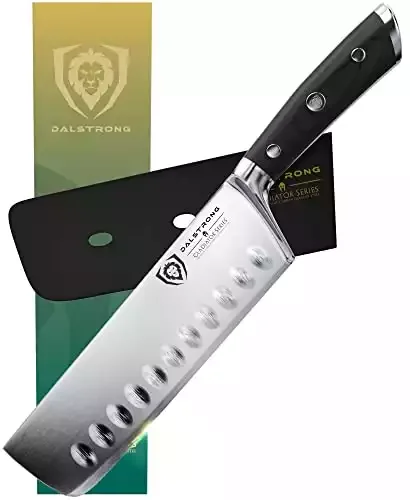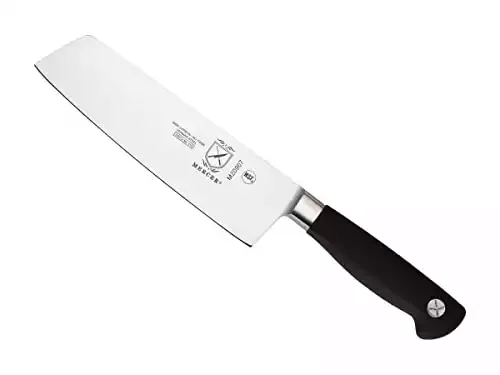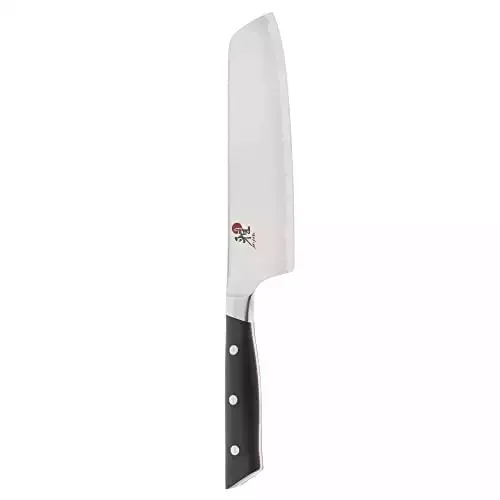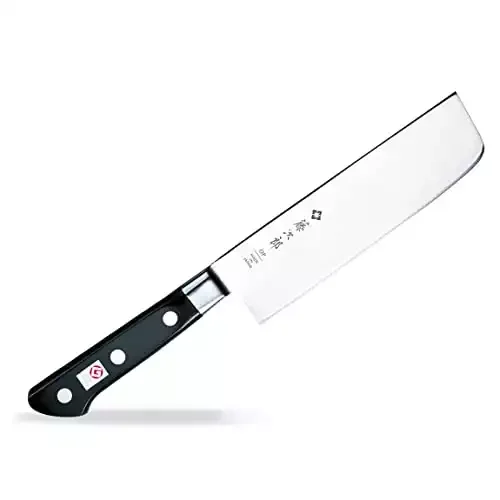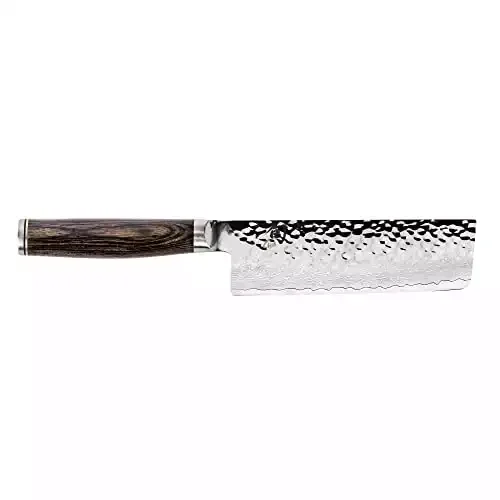Wanna know the trick to getting perfectly sliced vegetables like these?
It’s Japan’s specialty vegetable knife, the nakiri bocho. I was introduced to nakiri knives during my time working in a Japanese kitchen, and they’ve since become a staple in my home. Thanks to their thin, lightweight blades, nakiri knives make getting your daily servings of vegetables fast and easy.
And you know what might be the coolest part? The best nakiri knife for your kitchen won’t put a strain on your wallet. If that sounds good to you, read on — because I’ll be introducing you to my top three tried and tested nakiri knives for your home kitchen.
In This Article
Our Top Picks
- High carbon stainless steel is sharp, durable, and corrosion-resistant
- Full tang construction for maximum longevity and great balance
- Full bolster is an innovative addition that further emphasizes this knife’s balance
- As affordable as nakiri knives come
- Excellent quality steel gives a sharp and durable edge
- Non-slip, comfortable, and hygienic handle
- Special steel used in the blade makes it the thinnest and sharpest nakiri knife available
- Ice hardened finish makes this knife exceptionally durable
- Unparalleled in its ability to make precise cuts
Detailed Review of The Best Nakiri Knives
Dalstrong Gladiator Series Nakiri Vegetable Knife
I could hardly choose between a Western-style nakiri knife and a Japanese one — so I went with both. That’s what Dalstrong’s Gladiator Series nakiri knife feels like, anyway! By combining German stainless steel with a thin Japanese blade profile, it hits every performance benchmark I expect out of a knife.
In short: It’s sharp, durable, low maintenance, and comfortable to use. And the reasonable price is just icing on the cake.
First, the high carbon stainless steel. It’s German-made, resistant to corrosion, and almost as hard as Japanese steel. That gives Dalstrong’s nakiri impressive sharpness and edge retention. Plan on sharpening this knife every six months to a year, at most.
Full tang construction gives this nakiri exceptional durability, too. That means it’s forged from a single piece of steel that extends from the tip of the blade through the butt of the handle. In addition to increasing your knife’s longevity, this gives it a fine balance as well.
That balance is completed by a beefy full bolster that’s uncommon for this style of knife. I’m usually not a fan of the full bolster style, as it doesn’t let you use the full length of your blade. But since nakiri knives make vertical cuts rather than horizontal slicing motions, you don’t need the back edge of the blade.
The result? Better balance, and a nice safeguard for your lead finger, too.
Any of these qualities taken alone is a good sign for a nakiri knife. Put together, they make the Dalstrong Gladiator series my top choice for the best nakiri knife.
What we like
- High carbon stainless steel is sharp, durable, and corrosion-resistant
- Full tang construction for maximum longevity and great balance
- Full bolster is an innovative addition that further emphasizes this knife’s balance
What We don’t
- Every knife series from Dalstrong has a goofy name
Mercer Culinary Genesis, 7-Inch Nakiri Vegetable Knife
Budget-conscious cooks will appreciate Mercer Culinary’s attention to detail. The high carbon steel blade and ergonomic handle are as well made as a knife that would cost two to three times as much. Pair that with a best-in-class warranty, and you’ve got a nakiri knife that really delivers on value.
The blade on Mercer Culinary’s nakiri knife is made from German high carbon stainless steel. This allows it to have the classic thin profile that nakiris are known for, as well as excellent durability and edge retention. It’s made with a full tang construction, too, so you know it will last for a lifetime.
Speaking of which, this knife comes with a full lifetime warranty. That’s in addition to a 1-year satisfaction guarantee standard on all Mercer Culinary knives. Even though it’s remarkably affordable, this knife is also a safe investment in the long term.
Santoprene is an innovative material used in this nakiri’s handle. It’s as comfortable to use as hardwood, but also has the benefit of being non-slip and bacteria-resistant. In short, it’s a truly comfortable, safe, and hygienic handle. And in my experience, it provides a good balance to the lightweight blade as well.
What we like
- As affordable as nakiri knives come
- Excellent quality steel gives a sharp and durable edge
- Non-slip, comfortable, and hygienic handle
What We don’t
- May not give enough knuckle clearance for all chefs
Miyabi Evolution 6.5-inch Nakiri Knife
You don’t have to get the most advanced nakiri knife available on the market — but if you want to, you should look towards the Miyabi Evolution. It’s a product of Zwilling Henckels’ Japanese branch, combining the best of Japanese tradition and German innovation. As a result, this nakiri knife is sharper, more durable, and more comfortable than any I’ve seen or used.
The blade for Miyabi’s Evolution series nakiri knife is made of FC61 grade steel. In plain terms, this “fine carbide” steel allows the blade to be thinner, sharper, and more durable than other high carbon steels. Furthermore, the blade is finished with a special ice-hardening process that gives it incredible edge retention. I’d be quite surprised if you need to sharpen this knife more than once every 6 months.
That’s paired with a full tang construction, too, giving excellent balance and durability to the entire knife. Add in an ergonomic and lightweight handle, and you have a knife that makes it easy to achieve precise cuts. If you have the money in your kitchen budget, this knife has truly fantastic performance.
What we like
- Special steel used in the blade makes it the thinnest and sharpest nakiri knife available
- Ice hardened finish makes this knife exceptionally durable
- Unparalleled in its ability to make precise cuts
What We don’t
- Expensive!
Tojiro’s Nakiri knife was the closest contender for inclusion in my top three picks. It’s made with a super-strong VG-10 steel core that gives it good weight while maintaining a thin blade profile. That gives it a strong 60 Rockwell hardness, leading to a razor-sharp edge. The only reason it didn’t make my list is that it offers very little knuckle clearance. If you have smaller hands, I’d recommend it as an alternative to any of my top picks.
Shun Premier 5.5-Inch Nakiri
Shun is one of my favorite producers of Japanese knives, owing to their commitment to traditional knife-making methods. In the case of their Premier series nakiri, though, I don’t find that the performance justifies the cost. But the natural wood handle would make it a beautiful accent to a high-class kitchen.
Wusthof Classic Hollow Edge Full Tank 7” Nakiri Knife 4193-7
If the Miyabi Evolution in my picks caught your eye, I’d encourage you to consider Wusthof’s hollow edge nakiri as well. They’re both made of ultra high-quality steel, and hand-forged with a durable full tang construction. This makes both knives extremely sharp. Wusthof’s knife is a bit heavier than the Miyabi, though. Chefs who are used to Western knives might enjoy that weight, but I personally prefer the lightweight Japanese style.
Yoshihiro Hammered Damascus Usuba Vegetable Knife
There are Japanese knives, and then there are traditional Japanese knives. Yoshihiro is a picture-perfect example of the latter. From the hammered Damascus steel, to the super thin blade profile, to the octagonal hardwood handle, every detail is there. It is a gorgeous piece of craftsmanship, and carries a price tag to match. If I had double the kitchen budget for knives, this would be my first choice.
What To Look For
Below, I’ll be discussing the specific areas I focus on when looking for the best nakiri knife for my own kitchen. Once you get to know the anatomy of a knife, you’ll be able to make informed decisions about which brand is right for you. Put my experience and your preferences together, and you’ll have a foolproof method for finding the best nakiri to add to your kitchen.
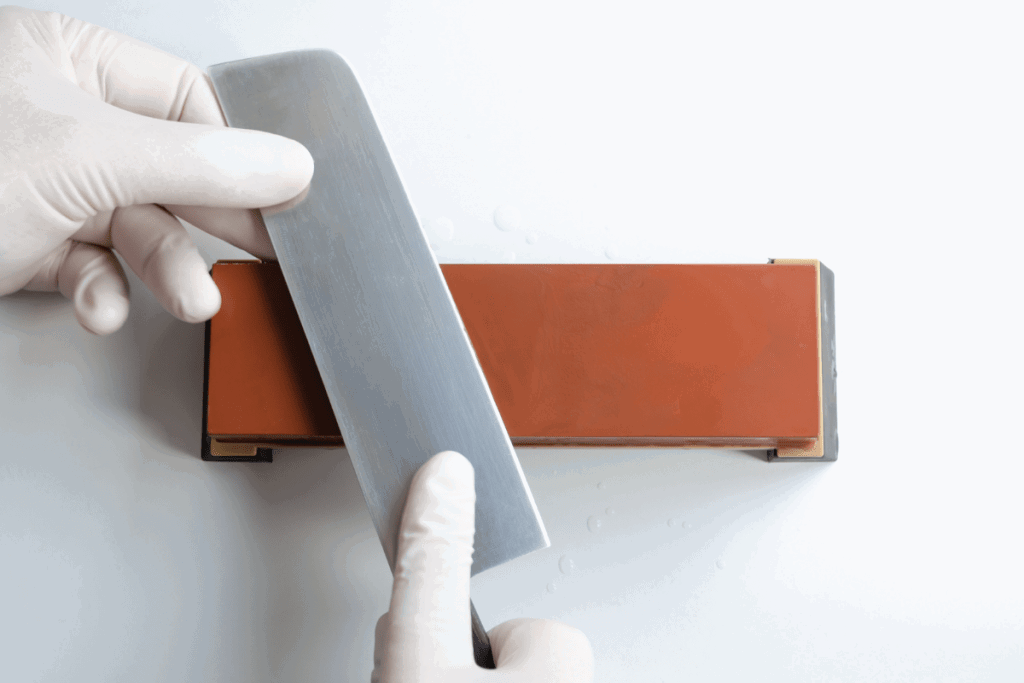
Materials
Any knife will only be as good as the materials it’s made of. In the case of nakiri knives, you should look for three main indicators of quality:
- A high carbon steel blade.
- A natural wood or hard synthetic handle.
- Full tang construction, i.e. the steel extends from the tip of the blade through the butt of the handle.
Taken together, these three signs show that a nakiri knife will be sharp, durable, and comfortable to use. In the next two sections, I’ll explore these concepts in greater detail.
Handle
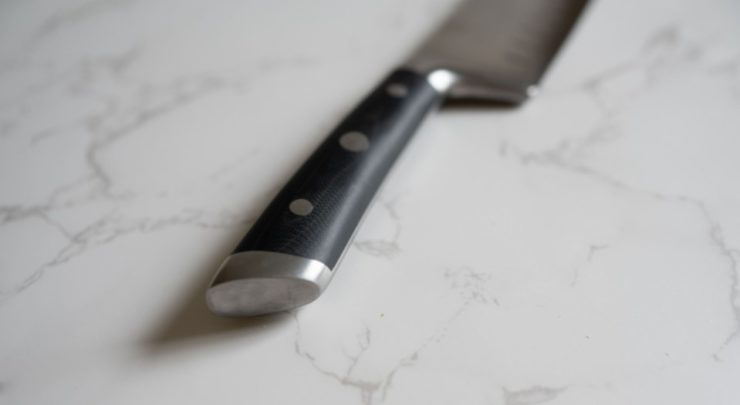
The handle for a nakiri has two important functions: Giving you a comfortable grip, and balancing the weight of the blade.
A comfortable grip comes from a combination of the handle’s shape and the material it is made of. Slightly curved handles offer a comfortable ergonomic grip. Traditional straight handles allow for maximum control. Look for a handle that gives your knuckles enough clearance to not bang against your cutting board while you work.
Both natural wood and hard synthetic handles afford a great balance for a nakiri knife. Natural wood has the advantage in the looks department, but synthetic handles are more hygienic and slip-resistant.
The final component of a nakiri’s handle is the bolster, the connecting point between the handle and the blade. Most nakiri knives feature an almost non-existent bolster, with just enough material to make the knife durable. My top pick, though, features a full bolster — giving greater protection for your lead finger while cutting. Either option is good, as long as the balance is there.
Blade
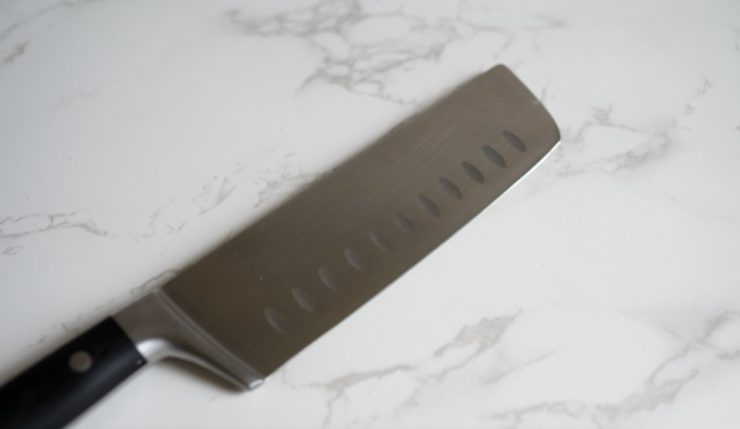
Every type of knife is defined by the specific characteristics of its blade. Taken as a whole, the following five blade characteristics make for a top-quality nakiri:
- The height of a nakiri knife should be matched with the shape of the handle to give your knuckles plenty of room. That means most nakiri blades will measure between 1 and 1.5 inches tall.
- Weight is an area where nakiri knives strongly depart from chef’s knives. They’re designed to be as lightweight as possible, to allow for precise cuts and deft maneuvering.
- Blade length is where you’ll find the greatest difference from brand to brand. The shortest nakiri knives will measure around 5.5 inches, while 7.5 inches is the top end of length. In my professional experience, 6.5 to 7 inches is the real sweet spot for a nakiri’s blade.
- The thickness of a nakiri knife’s blade falls directly in line with its weight. Unlike chef’s knives or cleavers that have thicker spines, nakiri blades are uniformly thin from spine to edge. This gives them a greater ability to make paper-thin cuts on vegetables.
- Balance is the fifth and final element, and a combination of everything that comes before it. When a nakiri has great balance, it will feel almost weightless while you’re cutting. This comes as a result of the materials used for the blade, bolster, and handle, as well as the forging process.
Cutting Edge
The angle of your nakiri’s cutting edge will determine whether it can make impressively thin cuts.
Traditional Japanese blades, with their harder steel, can be sharpened to steeper angles. This results in thinner, more precise cuts. The tradeoff is that Japanese blades and edges are more prone to chipping, and require more frequent sharpening to maintain the desired angle.
Western blades, with their softer steel, need to be sharpened to slightly wider angles. They may not be able to make the paper-thin cuts of Japanese steel, but they’re quite a bit more durable. That means greater edge retention, too, and less frequent sharpening as a result.
Price
How much should you spend on a nakiri knife? That depends on how much you plan on using it. If you’re a professional chef, budgeting more for a knife you use every day will pay off in enhanced performance. This usually translates to a longer and taller blade made with stronger steel. At-home chefs, though, can safely budget less than $100 for a high-quality nakiri knife.
Care Tips
As with every knife in your kitchen, properly caring for your nakiri will extend its longevity and increase its performance. Here are three things to keep in mind for getting the best out of your knives:
- Always keep your knives dry. Towel them off after each use, and store them in a cool dry place. This will prevent corrosion and staining.
- Consider learning how to sharpen your knives. A simple and affordable two-sided whetstone only takes a little bit of practice to use. And the results will ensure that you’re always making the cleanest cuts possible. The folks from Korin have a fantastic series of videos where you can learn to sharpen your own knives.
- Have a safe place to store your knives. If that’s a drawer in your kitchen, dedicate it just to knife storage. The last thing you want is your new knife getting chipped and banged up. Alternatively, a knife block or magnetic knife rack can be a real space saver.
Make sure you explore all types of Japanese knives before making a decision.
My Recommendations
With everything here in mind, are you confident in being able to pick out the best nakiri knife for your home kitchen? I certainly hope so. To recap, here’s why I think each of my top picks deserves a place in your kitchen:
The Dalstrong Gladiator Series Nakiri Vegetable Knife is a fine combination of Western and Japanese style knives. It’s my top choice for beginners in particular because of its full bolster design and affordable price.
The Mercer Culinary Genesis Nakiri Vegetable Knife offers a lot of utility at a very low price. If you’re just testing out whether a nakiri knife is a good fit for your kitchen, it’s the perfect place to start. Though to be fair, you might never upgrade from this surprisingly high-quality knife.
The Miyabi Evolution Nakiri Knife is a beautiful piece of traditional craftsmanship. Its sharpness and maneuverability are bordering on legendary. If I had the budget for it, I would buy this knife over any other nakiri — but it’s darned expensive.
FAQs
What Is A Nakiri Knife?
The full name for a nakiri gives away its original purpose.
Nakiri bocho, translated from Japanese, means “knife for cutting greens”. They’re also occasionally known as an usuba bocho, or “thin knife”. Either way, the intention is the same: Using these knives for preparing vegetables.
Designed with a boxy style, nakiri knives are made to cut differently than chef’s knives. They use a vertical chopping motion rather than a horizontal slicing motion. Combined with their thin blades, this makes nakiri knives uniquely capable of making paper-thin slices of vegetables. In contrast, thicker or heavier blades run the risk of breaking the vegetable pieces mid-cut.
What Advantages Does A Nakiri Knife Offer?
Nakiri knives are one of my favorite recommendations for home chefs. They complement beefier chef’s knives quite well, and help to speed up vegetable prep. Plus, a nakiri knife can let an amateur home chef practice their precision cuts. Spend a few months working with a nakiri, and you’ll develop a newfound appreciation for refined vegetable presentations.
What Is A Nakiri Knife Good For?
A nakiri knife’s purpose is contained in the translation of its name: “knife for cutting greens”. They excel at cutting any type of vegetable, from garlic and onions to carrots, tomatoes, potatoes, and more. If you’re trying to get more vegetables into your diet, a nakiri knife will make it easy to chop, mince, and dice to your heart’s content.
How Does A Nakiri Compare to A Chef Knife or Santoku?
The thin and lightweight nakiri knife is smaller and more maneuverable than either a chef’s knife or a santoku. This makes it a rock star for vegetable prep, but poorly suited for meat, fish, and poultry. Santoku knives can handle a little bit of everything, while you should leave the most heavy-duty kitchen tasks to a chef’s knife.
What Other Knives Should I Have In My Kitchen?
In my ideal fantasy world, I would have an unlimited budget for kitchen knives. No matter what intricate cut I wanted to make, I’d have the perfect knife for the job. Alas, the real world is a cruel place where I have to pay rent rather than buy a new Japanese blade every month.
If you’re in the same boat, I’d encourage you to check out my guide to the essential kitchen knives that every at-home chef should have. It will help you build a modest collection of knives that will handle 90% of cutting tasks in your kitchen.
